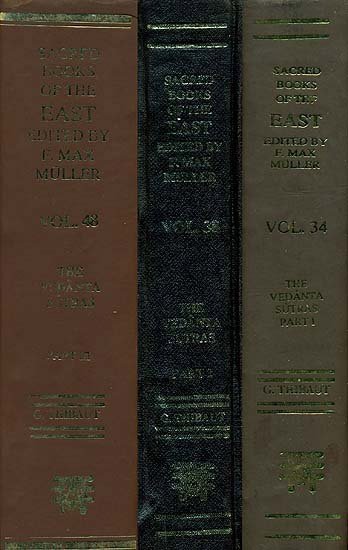Brahma Sutras (Ramanuja)
by George Thibaut | 1904 | 275,953 words | ISBN-10: 8120801350 | ISBN-13: 9788120801356
The English translation of the Brahma Sutras (also, Vedanta Sutras) with commentary by Ramanuja (known as the Sri Bhasya). The Brahmasutra expounds the essential philosophy of the Upanishads which, primarily revolving around the knowledge of Brahman and Atman, represents the foundation of Vedanta. Ramanjua’s interpretation of these sutras from a V...
Sutra 2.1.23
23. And as in the analogous case of stones and the like, there is impossibility of that.
In the same way as it is impossible that the different non-sentient things such as stones, iron, wood, herbs, etc., which are of an extremely low constitution and subject to constant change, should be one in nature with Brahman, which is faultless, changeless, fundamentally antagonistic to all that is evil, etc. etc.; so it is also impossible that the individual soul, which is liable to endless suffering, and a mere wretched glowworm as it were, should be one with Brahman who, as we know from the texts, comprises within himself the treasure of all auspicious qualities, etc. etc. Those texts, which exhibit Brahman and the soul in coordination, must be understood as conveying the doctrine, founded on passages such as 'of whom the Self is the body,' that as the jīva constitutes Brahman’s body and Brahman abides within the jīva as its Self, Brahman has the jīva for its mode; and with this doctrine the co-ordination referred to is not only not in conflict but even confirms it—as we have shown repeatedly, e.g. under Sū. I, 4, 22. Brahman in all its states has the souls and matter for its body; when the souls and matter are in their subtle state Brahman is in its causal condition; when, on the other hand, Brahman has for its body souls and matter in their gross state, it is 'effected' and then called world. In this way the co-ordination above referred to fully explains itself. The world is non-different from Brahman in so far as it is its effect. There is no confusion of the different characteristic qualities; for liability to change belongs to non-sentient matter, liability to pain to sentient souls, and the possession of all excellent qualities to Brahman: hence the doctrine is not in conflict with any scriptural text. That even in the state of non-separation-described in texts such as, 'Being only this was in the beginning'—the souls joined to non-sentient matter persist in a subtle condition and thus constitute Brahman’s body must necessarily be admitted; for that the souls at that time also persist in a subtle form is shown under Sūtras II, I, 34; 35. Non-division, at that time, is possible in so far as there is no distinction of names and forms. It follows from all this that Brahman’s causality is not contrary to reason.
Those, on the other hand, who explain the difference, referred to in Sūtra 22, as the difference between the jīva in its state of bondage and the jīva in so far as free from avidyā, i.e. the unconditioned Brahman, implicate themselves in contradictions. For the jiva., in so far as free from avidyā, is neither all-knowing, nor the Lord of all, nor the cause of all, nor the Self of all, nor the ruler of all—it in fact possesses none of those characteristics on which the scriptural texts found the difference of the released soul; for according to the view in question all those attributes are the mere figment of Nescience. Nor again can the Sūtra under discussion be said to refer to the distinction, from the individual soul, of a Lord fictitiously created by avidyā—a distinction analogous to that which a man in the state of avidyā makes between the shell and the silver; for it is the task of the Vedānta to convey a knowledge of that true Brahman which is introduced as the object of enquiry in the first Sūtra ('Now then the enquiry into Brahman') and which is the cause of the origination and so on of the world, and what they at this point are engaged in is to refute the objections raised against the doctrine of that Brahman on the basis of Smṛti and Reasoning.—The two Sūtras II, 1, 8; 9 really form a complementary statement to what is proved in the present adhikaraṇa; for their purport is to show also that things of different nature can stand to each other in the relation of cause and effect. And the Sūtra II, 1, 7 has reference to what is contained in the previous adhikaraṇa.
Here terminates the adhikaraṇa of 'designation of the other.'
